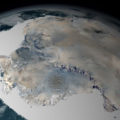
New research from the University of California – San Diego challenges the generally accepted belief that substantial ice sheets could not have existed on Earth during past super-warm periods. The study by researchers at Scripps Institution of Oceanography at UC San Diego provides strong evidence that a glacial ice cap, about half the size of the modern day glacial ice sheet, existed 91 million years ago during a period of intense global warming. The study, appearing in Science, offers valuable insights into current day climate conditions and the possibility of global sea level rise.
The new study examines geochemical and sea level data retrieved from marine microfossils deposited on the ocean floor 91 million years ago during the Cretaceous Thermal Maximum (also known as the super-greenhouse). This extreme warming event in Earth’s history raised tropical ocean temperatures to 35-37& #176;C (95-98.6& #176;F), about 10& #176;C (50& #176;F) warmer than today, thus creating an intense greenhouse climate.
The study found strong evidence that an ice sheet about 50-60 percent the size of the modern Antarctic ice cap existed for about 200,000 years. “Until now it was generally accepted that there were no large glaciers on the poles prior to the development of the Antarctic ice sheet about 33 million years ago,” said study co-author Richard Norris. “This study demonstrates that even the super-warm climates of the Cretaceous Thermal Maximum were not warm enough to prevent ice growth.”
The researchers are still unclear as to where such a large mass of ice could have existed in the Cretaceous or how ice growth could have started. They speculate that climate cycles may have favored ice growth during a few times in the Cretaceous when natural climate variations produced unusually cool summers. Likewise, high mountains under the modern Antarctic ice cap could have been potential sites for growth of large ice masses during the Cretaceous. Paradoxically, past greenhouse climates may have aided ice growth by increasing the amount of moisture in the atmosphere and creating more winter snowfall at high elevations and high latitudes.
Related articles
Missing Fallout Fuels Warming Fears
Icebergs – Oases Of The Ocean
West Antarctic Ice Sheet Gets Climatologists Hot And Bothered
Antarctic Snowfall Snafu Derails Climate Models


















Comments are closed.